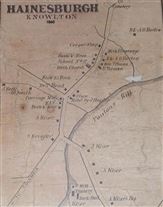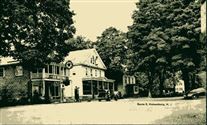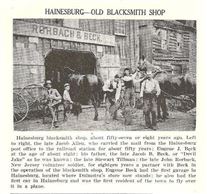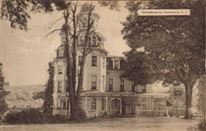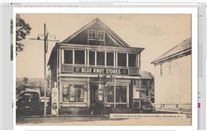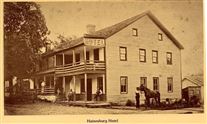Hainesburg1860.jpg
Hainesburg1860.jpg
Hainseburg
This ancient-looking village is located on the right bank of the Paulinskill Creek, about four miles from its confluence with the Delaware River, and the same
distance northeast from Columbia, and on the Hyndshaw
tract, surveyed ill 1729. For many years this locality bore
the name of "Sodom," whether to warn the dwellers therein of the fate that befell its ancient namesake, or for other and better reasons, we cannot say. Hainesburg was the name given when the postoffice was established, and that in honor of John Haines, who made a liberaa donation to the school district in which the village is located. For the same reason the school district was named "Hainesburg
District." From 1816 to 1843 the land upon which the village is situated was owned by Andrew Smith. His house
was a small one-story frame building, and stood on the south side of the foot of the lane that leads from the main road up to the present residence of Jabez Gwinnup Smith. In 1828, Andrew Smith built the old "Mansion House" on the C01'ller where John Beck now lives. Mr. Smith sold what is now the village property to Jacob M. Blair, about 1843, and Blair sold to the Beck brothers, when the land was cut up into village lots.
The storehouse in which is now the store of Dernberger
was built by Andrew Smith ahout 1835. In 1830 a store was kept in the old stone building, near where the railroad depot now stands, by William Johnston. Sherman & Shackelton were the first merchants in the building now occupied by Dernberger., They were succeeded by’ Jacob M. Blair, and he by William McCracken, who was followed by Joseph Andrus from 1860 to 1877, when I. Dernberger, the present merchant, assumed control of the mercantile business at Hainesburg. The pioneer tavern at this place was kept by a Mr. Ridgeway in the old "Mansion House," and in 1845 Lewis C. Weller hung out the first tavern-sign from the present hostelry. The pioneer blacksmith in Hainesburg was Isaac Allen, who located here in 1840. His shop stood on the site now occupied by the hotel shed. He was succeeded by a Mr. Robins, and he by James Snover, when the shop was moved across the road. The present wheelwright-shop was built by Jacob M. Blair, and sold by him to Beck, and by Beck to
Samuel Snover, whose estate now own the property.
The old stone grist-mill on the south side of the creek was built prior to the Revolutionary war. The "toll scooper" in 1835 was Ignatius Dockaday. He was succeeded by Bartley Lareu, who remained in charge of the old mill for several years. In 1840 a tannery was built, on the site now occupied by the saw-mill, by Jacob Hibler. He sold to
Aaron Kizer, and he to Levi Albertson. The tannery was quite an extensive one, in which a large amount of work was done. It was burned in 1849-50, and immediately rebuilt by Aaron Kizer, and in 1880 was removed to make room for a new saw-mill built, in 1881, by George Adams. Mr. Adams also built, in 1880-81, the frame grist-mill on the west side of the old stone mill. In January, 1881, there were at Hainesburg one church (Methodist Episcopal), one school-house, hotel by Robert Smith, store by I. Dernberger, two blacksmith-shops by Belles Brothers and Valentine Deitrick, grist-mill and chap-mill by George Adams, with John Linaberry as miller, saw-mill, wool-carding shop by David Pierce, railroad depot of the Blairstown Railway. William C. and John M. Belles are the wheelwrights. Joseph Andrus is the present postmaster.
The physicians at this place have been Drs. Mills, Wilson, Vaughn, Hunt, Bond, from 1850 to 1863, and Charles Kline, the present physician.
2006.000.000.jpg
2006.000.000.jpg
Hainseburg
This is a northern view of the old Route 8, now Route 94, in Hainesburg. At one time, this small hamlet featured a blacksmith shop, a wheelwright shop, a post office, two stores, a hotel, a church, a tannery, a grain mill and even a brewery. No longer a commercial hub, Hainesburg is largely residential and is probably best known for the architecturally unique Hainesburg Inn, whose sign is visible in the photo
2113.029.000.jpg
2113.029.000.jpg
Mansion House
The Mansion House or Andress home has been a pictorial landmark of Hainseburg for many years. Approaching this once productive settlement by railroad, the Andress home was indeed a breath-taking vision. Its castle-like structure amidst a combinded countryside and once flourishing town was a welcome sight to frequent visitors. Joeseph Andress and his family once lived in and owned the Mansion House. It was believed built by Andrew Smith in the early 1800’s. In addition to this house Mr. Andress also owned and operated two stores in Hainseburg.
The Hainseburg Inn, formally mansion House, is now Animal Mansion Veterinary Hospital owned and operated by Jon Bertoldo, DVM. [2014]
2006.000.002.jpg
2006.000.002.jpg
Hainesburg Hotel
At the right of the picture, Joesph Andress is sitting on the porch. George L. Andress is on the steps with his mother behind him. The other people in the picture are not identified. The Hainesburg Hotel burned down in about 1912. It stood just south of the present Hainesburg Inn.
GPS coordinates on the map indicate the location where the hotel once stood.
